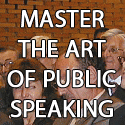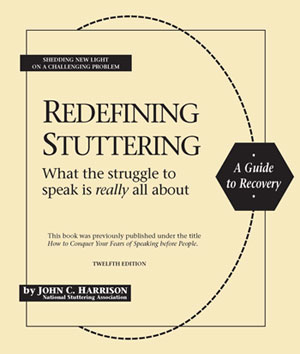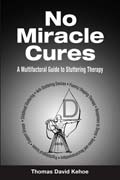As mentioned in my last post, people who stutter or stammer appear to have a lowered capacity to manage the speech mechanism, when their fear of speaking anxiety level goes above a certain threshold level. If we realise and accept that, we can start to look at what are the components that determine our level of speaking anxiety. Well I am going to let you in on a little known secret about the components that make up your speaking anxiety level, as a person who stutters or stammers, and what you can do to reduce your anxiety surrounding stuttering or stammering.
 There are two main components that contribute towards your speaking anxiety level, and your subconscious brain knows this, even if your conscious brain does not. In any situation where you have to speak, your brain does a quick “calculation” that basically will determine how anxious you become about that speaking situation. In simple terms, it takes each component, and gives it a rating out of 10, then multiplies the two ratings together, and that gives you an anxiety index level as a rating out of 100. Now this all happens in a fraction of a second without you knowing it.
There are two main components that contribute towards your speaking anxiety level, and your subconscious brain knows this, even if your conscious brain does not. In any situation where you have to speak, your brain does a quick “calculation” that basically will determine how anxious you become about that speaking situation. In simple terms, it takes each component, and gives it a rating out of 10, then multiplies the two ratings together, and that gives you an anxiety index level as a rating out of 100. Now this all happens in a fraction of a second without you knowing it.
So what are these two components that the brain considers in determining how anxious you are in any speaking situation. Well the first component is:
Probability.
Your subconscious brain asks itself this question. “What is the, probability, of me blocking or stuttering in this situation”? As mentioned above, the answer is effectively expressed in terms of a score out of 10. So if you “believe” for one reason or another that you will be totally fluent, then your brain gives that a score of 0. If you believe there is a bit of a chance that you will stutter, then your brain might give it a rating of 2 or 3. If however the assessment is that you are very likely to stutter, then a 7, 8 or 9 might be the rating. Now where does this assessed rating come from? Well, it is an accumulation of all your experiences of speaking to different people in different situations, and the older you get, the more of a reflex this subconscious calculation becomes.
The second of the two components is:
Consequence.
Your subconscious brain asks itself this question. “What will be the, consequence, of me stuttering in this situation”. Once again the answer is effectively expressed in terms of a rating out of 10. So if you believe for one reason or another, that it really does not matter if you block and stutter, and there will be no consequence at all, then your brain gives that a rating of 0. If there are some concerns about what the impact that your blocking and stuttering may have in some way, then the score starts to climb the scale to a 2, 3 or maybe a 4. Now if your assessment of the consequences of stuttering are such that you believe it is likely to be, catastrophic to you in some way, then the score can reach a 9 or even a 10. Ratings of 9 and 10 would have to fall into the category of a panic attack, and many people who stutter would know exactly what I am talking about here.
So let us say that your subconscious brain assesses the, Probability, of you stuttering as being a 4, and it assesses the, Consequence, of you stuttering as being a 2. The total rating the brain has assessed is an 8. That is a speaking anxiety index level of 8, out of a possible 100. Now if the speaking anxiety level where stuttering is likely to be triggered in is say, 20, then you are unlikely to stutter or speak with a level of dysfluency that is greatly noticeable to you. That is not to say that there will be no stuttering. It is just that it is likely to be of a level that is inconsequential or unnoticeable to you, and is basically a result of habit rather than dysfluency caused by anxiety and fear.
If on the other hand, your subconscious brain assesses the, Probability, of you stuttering as being a 9, and it assesses the, Consequence, of you stuttering as being a 5, the rating your brain has assessed, is 45. That is a speaking anxiety index level of 45, out of a possible 100. Once again, if your speaking anxiety level where stuttering is likely be triggered is 20, and your brain has the body at an anxiety index factor of 45, then a high level of stuttering will be evidenced, even though your concern about the speech dysfluency is only moderate.
Now, I do not want to complicate this any more than is necessasry in order to give you an understanding of the components that are making up your level of anxiety, but there is a third component that is related to Probability, and that is, Degree. By degree, I mean that a person who stutters my have a level of variability in the degree of their blocking or stuttering. Degree is also closely related to the anxiety rating in that the higher the anxiety rating, the higher the degree of dysfluency. This is a complex component because it is circular to some extent, in that a greater degree of stuttering can lead to a higher “consequence” score, and therefore a higher anxiety index rating. For the purposes of this post, we will ignore, degree, as a component in understanding anxiety.
So why is it important to understand these two main components that make up your anxiety level? Well for those of you who are mathematically inclined, you will have already realised that if you want to bring down your “anxiety index level”, then you can begin to eliminate a lot of the problem, if you agrees that a lot of your fluency problem is related to your anxiety level.
It is clear then, to bring down the anxiety level, you have to find ways of reducing the probability of speaking dysfluently and/or reducing the consequence of such speech dysfleuncy.
In previous posts we have spoken, in broad terms, about the options that are available to facilitate a person in the process of reducing the, “probability of stuttering”, to a degree that it is not a concern, however, we will assume that the person is unable for one reason or another to reduce the probability of dysfluent speech, or that, even though their physical stuttering has been reduced, or even eliminated, they are still concerned about the consequences of blocking or stuttering, if it was to occur . We must then begin to work on reducing the consequence of speech dysfluency, and this will be the topic of my next blog post, so in that regard I once again invite you to subscribe to my RSS feed, or my email notification, so that you do not miss my next post, where we will talk extensively about how to reduce the consequences of blocking and stuttering. Finally, I urge you to make a comment on what I have outlined here. Thank you.
Comments:








